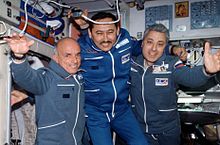
Soyuz TMA-2 was a Soyuz mission to the International Space Station (ISS) launched by a Soyuz FG launch vehicle. The spacecraft docked with the ISS 2003-04-28 and undocked 2003-10-27. Soyuz TMA-2 was the second flight for the TMA modification of the Soyuz spacecraft, and the 6th Soyuz to fly to the ISS.

Yuri Ivanovich Malenchenko is a retired Russian cosmonaut. Malenchenko became the first person to marry in space, on 10 August 2003, when he married Ekaterina Dmitrieva, who was in Texas, while he was 240 miles over New Zealand, on the International Space Station. As of June 2016, Malenchenko ranks second for career time in space due to his time on both Mir and the International Space Station (ISS). He is a former Commander of the International Space Station.

Yury Valentinovich Lonchakov is a Russian former cosmonaut and a veteran of three space missions. He has spent 200 days in space and has conducted two career spacewalks.

Yuri Pavlovich Gidzenko is a Russian cosmonaut. He was a test cosmonaut of the Yuri Gagarin Cosmonaut Training Center (TsPK). Gidzenko has flown into space three times and has lived on board the Mir and the International Space Station. He has also conducted two career spacewalks. Although he retired on July 15, 2001, he continued his employment by a special contract until Soyuz TM-34 concluded. Since 2004 to May 2009, Gidzenko was the Director of the 3rd department within the TsPK. Since May 2009 he serves as the Deputy Chief of Cosmonaut Training Center TsPK.
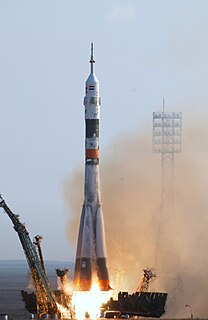
Soyuz TMA-4 was a Soyuz mission to the International Space Station (ISS) launched by a Soyuz FG launch vehicle. It was launched on April 19, 2004 (UTC) from Baikonur Cosmodrome. Gennady Padalka from Russia, Michael Fincke from the US and André Kuipers from the Netherlands were flown to the International Space Station. Kuipers returned to Earth 9 days later together with ISS crew 8 with the re-entry module of the Soyuz TMA-3, the other two stayed as ISS crew 9. The craft landed October 24, 2004 with Padalka, Fincke and Yuri Shargin aboard.

Gennady Ivanovich Padalka is a Russian Air Force officer and a Roscosmos cosmonaut. Padalka currently holds the world record for the most time spent in space, at 879 days. He worked on both Mir and the International Space Station.
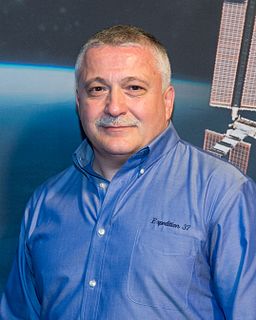
Fyodor Nikolayevich Yurchikhin is a Russian cosmonaut of Greek descent, engineer and RSC Energia test-pilot who has flown on five spaceflights. His first spaceflight was a 10-day Space Shuttle mission STS-112. His second was a long-duration stay aboard the International Space Station (ISS) as a Flight Engineer for Expedition 15; for this mission he was launched in the Soyuz TMA-10 spacecraft. He has undertaken two further long-duration stays aboard the ISS, as a crew member of Expedition 24 / 25. For this mission he was launched with the spacecraft Soyuz TMA-19, and he landed in November 2010, also with the Soyuz TMA-19 spacecraft. He served as Soyuz commander for his fourth mission aboard Soyuz TMA-09M, as flight engineer for Expedition 36 and ISS Commander for Expedition 37. In April 2017, Yurchikhin launched on Soyuz MS-04 for the fifth spaceflight of his career, a six-month mission to the ISS as part of Expedition 51 and 52, for which he was the commander.

Soyuz TM-34 was the fourth Soyuz mission to the International Space Station (ISS). Soyuz TM-34 was launched by a Soyuz-U launch vehicle.

Soyuz TM-33 was a crewed Russian spaceflight which launched on October 21, 2001, on the Soyuz-U launch vehicle. It carried Russian cosmonauts Viktor Afanasyev, Konstantin Kozeyev, and French cosmonaut Claudie Haigneré to the International Space Station.

Soyuz TM-31 was the first Soyuz spaceflight to dock with the International Space Station (ISS). The spacecraft carried the members of Expedition 1, the first long-duration ISS crew. It was launched from Baikonur Cosmodrome in Kazakhstan at 07:52 UT on October 31, 2000 by a Soyuz-U rocket.

Soyuz TMA-5 was a Soyuz mission to the International Space Station (ISS) launched by a Soyuz-FG launch vehicle.

Pavel Vladimirovich Vinogradov is a cosmonaut and former commander of the International Space Station. As of May 2013, he has flown into space three times, aboard Mir and the International Space Station, and is one of the top 10 astronauts in terms of total time in space. Vinogradov has also conducted seven spacewalks in his cosmonaut career, and holds the record for the oldest person to perform a spacewalk.

Pirs(Russian: Пирс, meaning "pier") – also called Stykovochny Otsek 1 and DC-1 – was a Russian module on the International Space Station (ISS). Pirs was launched on 14 September 2001, and was located on the Zvezda module of the station. It provided the ISS with one docking port for Soyuz and Progress spacecraft, and allowed egress and ingress for spacewalks by cosmonauts using Russian Orlan space suits. Pirs was docked to Zvezda for almost 20 years, until 26 July 2021, where it was decommissioned and undocked by Progress MS-16 to make way for the new Nauka module.

Soyuz TMA-6 was a human spaceflight to the International Space Station (ISS). It carried three crew members of Expedition 11 to the International Space Station. It was the 26th crewed flight to the ISS. It was launched by a Soyuz FG and returned to earth after performing operations at the ISS.

Soyuz TMA-7 was a transport mission for portions of the International Space Station (ISS) Expedition 12 crew launched October 1, 2005. The flight delivered ISS Commander William McArthur and ISS Flight Engineer Valery Tokarev to the station to replace Expedition 11 crew members. Spaceflight Participant Gregory Olsen joined the TMA-7 crew for the ascent and docking with the ISS, spent approximately eight days aboard conducting experiments, then returned to Earth with the outgoing members of Expedition 11 aboard Soyuz TMA-6. McArthur and Tokarev were joined on their return trip to Earth by Flight Engineer Marcos Pontes who launched aboard Soyuz TMA-8 and spent approximately seven days aboard the ISS conducting experiments for the Brazilian Space Agency.

Soyuz TMA-9 was a Soyuz mission to the International Space Station (ISS) launched by a Soyuz FG launch vehicle. It was a human spaceflight mission transporting personnel to and from the ISS. It launched from the Baikonur Cosmodrome on 18 September 2006 at 08:09 MSD, docked with the ISS at 09:21 MSD on 20 September, and returned to Earth on 21 April 2007. Soyuz TMA-9 transported two-thirds of ISS Expedition 14 to the space station along with one "spaceflight participant" who performed several experiments on behalf of the European Space Agency.

Expedition 14 was the 14th expedition to the International Space Station (ISS). Commander Michael López-Alegría, and flight engineer Mikhail Tyurin launched from Baikonur Cosmodrome on 18 September 2006, 04:09 UTC, aboard Soyuz TMA-9. They joined Thomas Reiter, who had arrived at the ISS on 6 July 2006 aboard Space Shuttle Discovery during mission STS-121. In December 2006, Discovery mission STS-116 brought Sunita Williams to replace Reiter as the third member of Expedition 14. On 21 April 2007, López-Alegría and Tyurin returned to Earth aboard TMA-9. Landing occurred at 12:31:30 UTC.

Soyuz TMA-10 was a human spaceflight mission using a Soyuz-TMA spacecraft to transport personnel to and from the International Space Station (ISS). The mission began at 17:31:09 UTC on April 7, 2007 when the spacecraft was launched from the Baikonur Cosmodrome by a Soyuz FG launch vehicle. Soyuz TMA-10 brought to the station two members of ISS Expedition 15 crew, along with one spaceflight participant. It remained at the space station as an escape craft until it was replaced by Soyuz TMA-11 in October 2007.
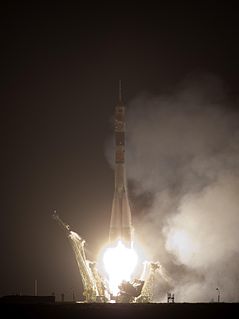
Soyuz TMA-17 was a human spaceflight mission to the International Space Station (ISS). TMA-17 crew members participated in ISS Expedition 22 and Expedition 23. The mission ended when the Soyuz TMA-17 capsule landed on 2 June 2010.
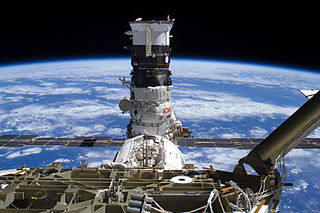
Poisk, also known as the Mini-Research Module 2, Малый исследовательский модуль 2, or МИМ 2, is a docking module of the International Space Station. Its original name was Docking Module 2, as it is almost identical to the Pirs Docking Compartment. Added in 2009, Poisk was the first major Russian addition to the International Space Station since 2001. Poisk is overall the same design as the docking module Pirs. Whereas Pirs had been attached to the nadir ("bottom") port of Zvezda, Poisk is attached to the zenith ("top"); Pirs was closer to the Earth with the ISS in its usual orientation, and Poisk is on the other side. Poisk is Russian for explore or search. Poisk combines various docking, EVA, and science capabilities. It has two egress hatches for EVAs in addition to the two spacecraft docking ports. Although Poisk is designated as Mini-Research Module 2, it arrived before Mini-Research Module 1 (Rassvet), which had a different design; Poisk looks more like the Pirs docking port, which is not designated as a mini-research module.


